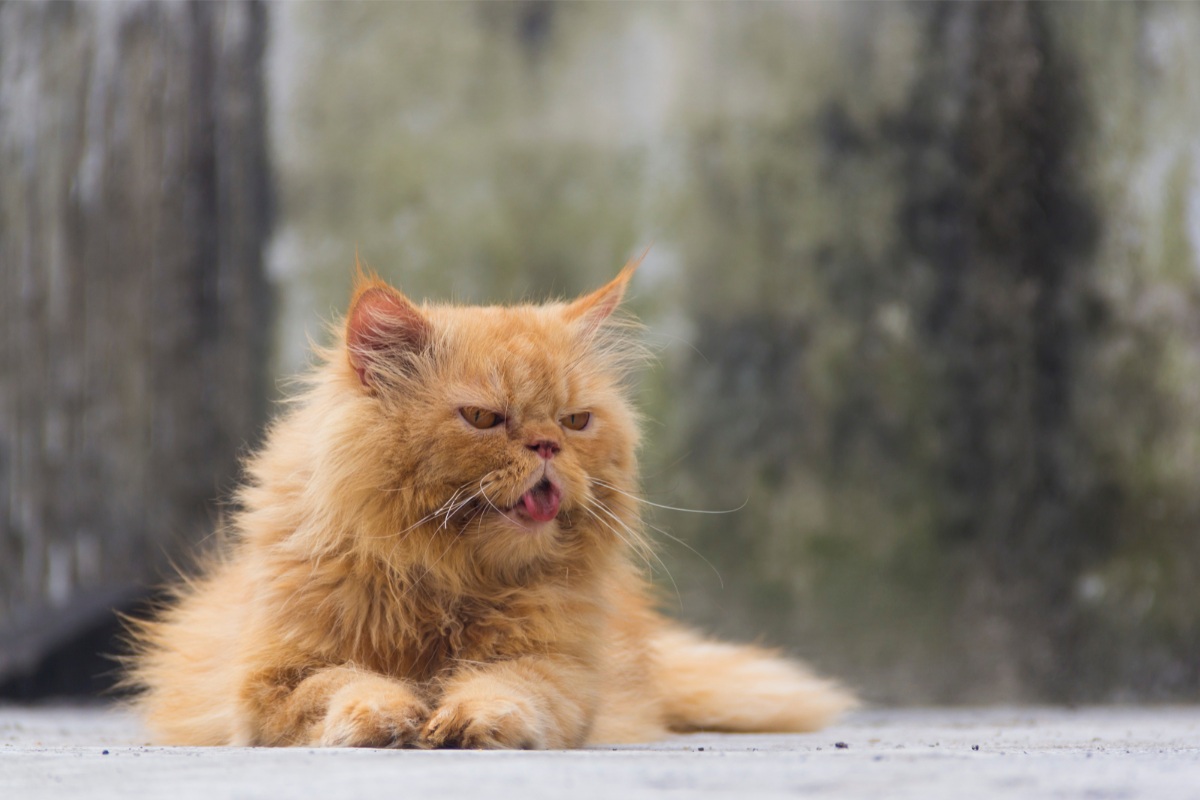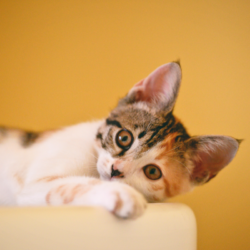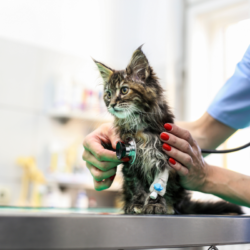Hyperthyroidism is one of the most common hormonal disorders in older cats. Overproduction of thyroid hormones causes this condition, which can have serious consequences if not treated quickly.
What causes this disease?
Feline hyperthyroidism results from a disorder of the thyroid gland, which is responsible for producing thyroid hormones (T3 and T4), essential for regulating the metabolism.
In 98% of cases, benign nodular hyperplasia causes hyperthyroidism in cats. This excessive but non-cancerous proliferation of thyroid tissue generates an overproduction of hormones. More rarely, in 1 to 2% of cases, a thyroid adenocarcinoma, a malignant tumour, triggers the disease. In addition, an ectopic thyroid, abnormally located in the thoracic cavity, sometimes disrupts normal functioning and in exceptional cases causes hyperthyroidism.
Environmental factors, such as exposure to chemical substances (endocrine disruptors), could play a role in the onset of the disease. Researchers are studying certain components of cat food, such as iodine-rich preservatives and household pollutants, as potential factors.
Finally, genetic predispositions have been identified, although these are rare. Certain breeds, such as Siamese and Himalayan, appear to be less prone to this disease. Hyperthyroidism mainly affects cats over 10 years of age.
What are the symptoms of hyperthyroidism?
Feline hyperthyroidism causes a variety of symptoms, all linked to an overactive metabolism.
Common symptoms :
- Weight loss despite increased appetite.
- Increased thirst and urination (polyuro-polydipsia).
- Digestive disorders such as vomiting or diarrhoea.
- Hyperactivity, irritability and nocturnal vocalisations.
- Dull, unkempt coat.
Less frequent symptoms:
- Appearance of a palpable nodule on the neck.
- Behavioural changes, such as aggressiveness or looking for freshness.
- Sudden blindness linked to high blood pressure.
- Muscle weakness or tremors.
In some cases, the cat may be asymptomatic. During an annual check-up at the vet, blood tests can detect adventitious hyperthyroidism by revealing high levels of thyroxine (T4).
How is it diagnosed?
The diagnosis of hyperthyroidism in cats is based on a rigorous procedure involving several stages. It all starts with a clinical suspicion based on symptoms observed by the owner or detected by the vet during a physical examination. A palpable thyroid nodule, significant weight loss or cardiac abnormalities, such as tachycardia or a murmur, may point to this pathology.
The diagnosis is confirmed by a blood test, which measures the level of thyroxine (T4) in the blood. A high concentration of this hormone is a characteristic sign of hyperthyroidism. However, in some cases, the results may remain within normal limits despite strong clinical suspicion. Natural fluctuations in T4 levels or the presence of a concomitant disease may mask the abnormalities. In these situations, it is recommended that the test be repeated or that complementary hormone assays be used, such as free T4, which is more sensitive.
Once hyperthyroidism has been confirmed, it is essential to look for potential complications. Blood pressure is often measured to assess the risk of arterial hypertension, a frequent complication of this disease. An echocardiogram can identify any repercussions on the heart, such as myocardial hypertrophy. At the same time, urine and blood tests are carried out to detect any renal dysfunction, which is often masked by hyperthyroidism.
Finally, in cases where surgery is being considered,imaging tests such as CT scans or scintigraphy are carried out. These techniques make it possible to pinpoint thyroid lesions and determine their nature, making it easier to plan an appropriate operation.
What treatments are available?
The aim of treating hyperthyroidism in cats is to reduce excess thyroid hormone production, relieve symptoms and prevent long-term complications. The choice of treatment depends on a number of factors, including the cat’s age, general state of health and the presence of any concomitant illnesses, such as kidney failure.
Medical treatment is often the first choice. It is based on the administration of antithyroid drugs, such as methimazole, which inhibit the excessive production of hormones. This treatment is effective and inexpensive, but requires daily doses and regular veterinary monitoring to adjust doses and monitor any side effects, such as vomiting, anorexia or itching.
Another option is to use a specific iodine-depleted diet. This approach limits the production of thyroid hormones by depriving the gland of the element essential for their manufacture. However, this diet requires strict exclusivity.
Radiotherapy, or iodotherapy, is a definitive solution involving the injection of radioactive iodine. This targets abnormal thyroid tissue and destroys it without affecting other organs. Although highly effective, this treatment remains costly and involves prolonged hospitalisation of the animal to limit exposure to radioactivity.
Finally, surgery may be considered. Removal of the affected thyroid lobes, known as thyroidectomy, is a delicate but definitive operation. It requires prior assessment of renal function to avoid revealing masked renal failure. Although moderately costly, this approach carries the risk of complications, such as hypothyroidism or nerve damage, which must be taken into account.
In all cases, whatever treatment is chosen, regular veterinary monitoring is essential.
What are the natural alternatives?
Natural alternatives complement conventional medicine to support the thyroid and relieve the symptoms of hyperthyroidism in cats. However, they should not replace appropriate medical treatment, as they generally do not allow the disease to be controlled independently. Here are the main natural options available.
Several plants and supplements can help balance thyroid function and improve a cat’s overall health. Lemon balm (Melissa officinalis) is particularly interesting: it helps maintain normal thyroid hormone levels while supporting a calmed nervous system. Milk thistle is also often recommended for strengthening the liver, an organ that is particularly stressed in hyperthyroid cats.
Carnitine, an amino acid, can also play a key role. In cats with hyperthyroidism, the body tends to run out of carnitine. Supplementation (125 to 250 mg, twice a day) can help reverse certain symptoms while supporting muscular and metabolic health. Other supplements such as digestive enzymes, essential fatty acids and vitamin C help to boost the animal’s immunity and general vitality.
Diet plays a crucial role in the management of thyroid disease. An iodine-free diet, offered by some veterinary brands, can limit thyroid hormone production. However, this type of diet is strict and must be followed exclusively. It is particularly suitable for indoor cats, as any intake of outdoor food could compromise its effectiveness.
Moderate physical activity, such as play sessions or short walks, helps to keep the metabolism balanced. At the same time, it is essential to monitor the animal’s overall health in collaboration with a vet, in particular to identify underlying diseases, such as kidney failure, which is often masked by hyperthyroidism.
What are the means of prevention?
Although it is difficult to prevent hyperthyroidism completely, certain measures can reduce the risks:
- Regular check-ups: Have your cat examined every year, especially if she’s older, to detect any early signs.
- High-quality food: Offer a balanced diet and avoid foods rich in chemical additives or iodine.
- Reduce environmental toxins: Limit exposure to the endocrine disruptors found in certain household products and textiles.
- Careful observation: Watch for even subtle changes in your cat’ s behaviour or health.
Regular monitoring with your vet is the key to ensuring optimum management of this disease.





